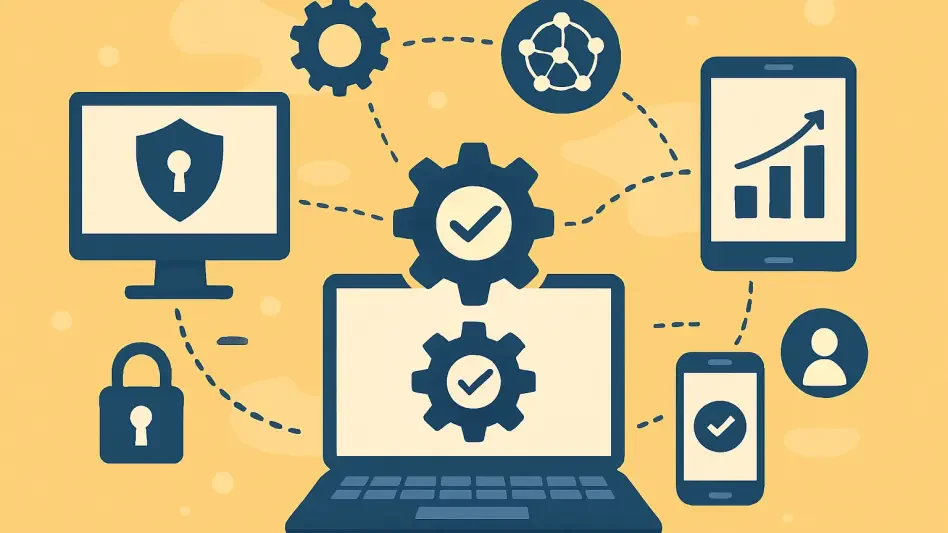In an era where digital transformation is reshaping every facet of business operations, the management and security of endpoint devices have become paramount challenges for organizations across the globe, making Autonomous Endpoint Management (AEM) tools indispensable. These solutions harness the power of artificial intelligence (AI), automation, and predictive analytics to oversee distributed devices with minimal human oversight, revolutionizing IT operations. They offer self-healing capabilities, real-time threat detection, and seamless scalability, ensuring businesses can keep pace with an increasingly complex technological landscape. As endpoint devices proliferate in remote and hybrid work environments, the urgency to adopt robust AEM solutions has never been greater, making them a cornerstone for enhancing productivity and safeguarding digital assets. This article dives into the leading AEM tools shaping the industry in the current year, meticulously evaluated based on automation prowess, security features, integration potential, scalability, and cost-effectiveness. By exploring these cutting-edge solutions, the aim is to provide IT administrators, small business owners, and enterprise leaders with actionable insights to select the most fitting tools for their unique needs. The journey through this technological frontier reveals how AEM is not just an option but a strategic necessity for future-proofing IT infrastructure and maintaining operational resilience in a dynamic digital world.
Revolutionizing IT with AI and Automation
The backbone of modern AEM tools lies in their ability to leverage AI-driven automation, fundamentally transforming how endpoint devices are managed and maintained. Unlike traditional systems that rely heavily on manual intervention, these platforms predict potential issues before they manifest and address them autonomously through features like automated patching and self-healing mechanisms. Tools such as Ivanti Neurons exemplify this trend with their use of AI microbots that independently repair devices, significantly reducing the workload on IT teams. IBM MaaS360 also stands out by incorporating predictive analytics powered by advanced AI, enabling proactive management that anticipates and mitigates disruptions. This shift toward intelligent automation means that routine tasks, which once consumed hours of manual effort, are now handled seamlessly, allowing IT personnel to redirect their focus to strategic initiatives. The result is a marked improvement in operational efficiency, with minimized downtime and enhanced device reliability becoming the norm across organizations adopting these solutions.
Beyond the immediate benefits of workload reduction, the integration of AI in AEM tools fosters a culture of proactive IT management that is reshaping industry standards. The ability to foresee vulnerabilities and deploy preemptive fixes is evident in platforms like Tanium, which offers real-time detection and rapid patching capabilities at an unprecedented scale. This forward-thinking approach not only curbs potential threats but also builds a resilient IT environment capable of adapting to evolving challenges. Businesses benefit from a significant decrease in system outages, ensuring continuity even in high-pressure scenarios. Moreover, the consistency of AI-driven processes eliminates human error, providing a dependable framework for endpoint management. As automation becomes ubiquitous among the top tools, it signals a broader industry consensus that reactive strategies are obsolete, paving the way for a future where autonomous systems are integral to sustaining competitive advantage in a tech-driven marketplace.
Prioritizing Endpoint Security in a Threat-Laden Era
With cyber threats growing in sophistication and frequency, endpoint security has emerged as a non-negotiable priority for AEM tools in the current landscape. These platforms are designed not only to manage devices but also to fortify them against an array of digital risks through advanced features like real-time threat detection and zero-trust architecture. BlackBerry Spark Suite, for instance, is renowned for its security-first philosophy, making it a preferred choice for industries with stringent regulatory demands such as healthcare and finance. Its AI-driven threat prediction capabilities enable organizations to stay ahead of potential breaches, safeguarding sensitive data with unwavering precision. Similarly, Microsoft Intune integrates robust security protocols within its ecosystem, offering comprehensive protection that aligns seamlessly with other Microsoft services. This focus on security ensures that distributed endpoints, often vulnerable in remote work settings, remain shielded from exploitation.
The convergence of endpoint management and cybersecurity is a defining characteristic of today’s AEM solutions, reflecting an industry acknowledgment that the two disciplines are inseparable. Tools like VMware Workspace ONE emphasize compliance enforcement alongside threat mitigation, providing detailed reporting to meet legal and industry standards. This dual focus addresses the critical need for organizations to not only protect their devices but also adhere to regulatory frameworks, avoiding costly penalties and reputational damage. The implementation of zero-trust models across these platforms further enhances security by assuming no device or user is inherently trustworthy, requiring continuous verification. As cyber risks continue to evolve, the commitment of AEM tools to integrate cutting-edge defense mechanisms offers businesses a vital layer of assurance, ensuring that their digital perimeters are robustly guarded against both current and emerging threats.
Catering to Diverse Organizational Scales
Recognizing that businesses vary widely in size and complexity, the leading AEM tools are crafted to address a spectrum of organizational needs, from small startups to sprawling global enterprises. For small to medium-sized businesses (SMBs), platforms like NinjaOne and Splashtop provide user-friendly interfaces and cost-effective solutions that do not compromise on core functionality. These tools are designed with simplicity in mind, enabling smaller IT teams to manage endpoints without the need for extensive technical expertise or substantial financial investment. Their intuitive dashboards and straightforward deployment processes ensure that even businesses with limited resources can maintain efficient device oversight, reducing operational hiccups and enhancing productivity. This accessibility democratizes advanced endpoint management, allowing SMBs to compete on a technological level playing field.
In contrast, large enterprises with intricate, globally distributed environments require solutions that can scale effortlessly to manage thousands of devices across multiple regions. Tools such as Tanium and Adaptiva OneSite are engineered to meet these demands, offering unparalleled scalability and specialized features like peer-to-peer content distribution to optimize bandwidth in challenging settings. Tanium, for example, excels in rapid vulnerability detection and patching for vast networks, ensuring consistency and security at scale. Adaptiva OneSite addresses unique logistical challenges by facilitating efficient content delivery, which is crucial for organizations with dispersed workforces. These enterprise-grade solutions cater to the complexities of large-scale operations, providing the robustness needed to handle high-stakes environments while maintaining seamless performance. The diversity in AEM offerings ensures that whether a business operates locally or globally, there is a tailored tool to support its endpoint management strategy effectively.
Seamless Integration with Existing IT Frameworks
A critical factor in the adoption of AEM tools is their ability to integrate smoothly with existing IT ecosystems, minimizing disruption and maximizing efficiency. For organizations deeply embedded in specific technology stacks, certain tools offer distinct advantages through native compatibility. Microsoft Intune, for instance, is a standout for businesses utilizing Microsoft 365 or Azure, providing a cohesive experience that aligns endpoint management with broader productivity and security suites. This tight integration reduces the learning curve and enhances functionality, as data and policies flow effortlessly across platforms. Similarly, VMware Workspace ONE serves as a natural fit for environments leveraging the VMware ecosystem, ensuring that endpoint management complements virtualization and cloud strategies without friction.
For organizations with heterogeneous or hybrid infrastructures, flexibility in deployment and compatibility is paramount, and several AEM tools rise to this challenge. ManageEngine Endpoint Central offers versatility with both cloud and on-premises options, accommodating diverse IT setups while delivering comprehensive endpoint control. Ivanti Neurons also prioritizes adaptability, supporting varied environments through its automation-focused approach, ensuring that businesses can tailor their endpoint strategies to specific operational needs. This emphasis on interoperability highlights the importance of AEM tools as enhancers rather than disruptors of current workflows. By aligning with existing systems, these solutions enable organizations to build on their technological foundations, integrating endpoint management as a seamless extension of their IT architecture, thus fostering continuity and operational harmony.
Navigating Cost and Accessibility Challenges
Budget considerations play a pivotal role in the selection of AEM tools, particularly for organizations mindful of financial constraints. For SMBs and mid-sized entities, affordability is often a deciding factor, and several top-tier solutions cater to this need without sacrificing quality. Splashtop and ManageEngine Endpoint Central are prime examples, delivering essential endpoint management features at a fraction of the cost of premium alternatives. Splashtop combines remote access with AEM capabilities, offering a practical solution for distributed teams on a budget. ManageEngine Endpoint Central provides a broad suite of tools including patching and asset tracking, ensuring cost-conscious businesses can still access robust functionality. This focus on accessibility ensures that effective endpoint management is within reach for organizations that might otherwise struggle with high investment barriers.
At the other end of the spectrum, enterprise-grade tools often come with higher price tags, reflecting their advanced capabilities and suitability for complex, security-intensive environments. Platforms like Tanium and BlackBerry Spark Suite justify their costs with features tailored for large-scale operations, such as rapid, large-volume patching and AI-driven threat prediction. These solutions are designed for businesses where the stakes of endpoint failure or security breaches are exceptionally high, making the investment worthwhile for long-term stability and protection. The range of pricing models among the leading AEM tools illustrates a balanced market where options exist across financial spectrums. Organizations can weigh the trade-offs between cost and advanced features, selecting a tool that aligns with their budgetary limits while meeting critical operational requirements, ensuring that endpoint management remains both accessible and strategically viable.
Enhancing User Experience and Deployment Simplicity
The usability of AEM tools significantly influences their adoption and effectiveness within organizations, as complex systems can deter implementation, especially for teams with limited technical resources. NinjaOne and Splashtop are leaders in this regard, offering intuitive designs that simplify endpoint management for SMBs and smaller IT departments. NinjaOne’s cloud-native platform provides straightforward navigation and powerful automation, enabling quick setup and minimal training. Splashtop enhances user experience by integrating remote access with management features, ensuring that even non-technical staff can handle basic tasks effortlessly. This emphasis on ease of use lowers the entry barrier, allowing businesses to deploy effective solutions without the need for extensive onboarding or specialized skills, thereby accelerating the realization of operational benefits.
For larger enterprises, the trade-off between complexity and capability often comes into play, as more robust tools require greater investment in deployment planning and user training. IBM MaaS360 and Tanium, while packed with sophisticated features like predictive analytics and massive-scale patching, demand a steeper learning curve and more strategic implementation efforts. IBM MaaS360 leverages AI for proactive management, necessitating a deeper understanding of its analytics to fully utilize its potential. Tanium’s comprehensive capabilities for global networks require meticulous setup to ensure optimal performance across diverse environments. Despite these challenges, the long-term advantages of such tools often outweigh initial hurdles, as they provide unmatched depth for managing intricate IT landscapes. The spectrum of user experiences across AEM solutions underscores the importance of aligning tool selection with organizational capacity, ensuring that deployment simplicity or advanced functionality matches the specific context of the business.
Future-Focused Trends in Endpoint Management
Examining the broader trajectory of AEM tools reveals pivotal trends that are defining the current landscape and setting the stage for ongoing evolution. A universal push toward fully autonomous systems is evident, with self-healing and predictive capabilities becoming standard across platforms. This trend signifies a departure from manual IT interventions, as businesses increasingly rely on proactive strategies to preempt and resolve endpoint issues. The adoption of AI to drive these autonomous functions is not merely a feature but a fundamental shift, ensuring that systems can adapt to new challenges without constant human oversight. This movement toward autonomy is reshaping expectations, positioning AEM as a critical component of efficient, forward-thinking IT operations that prioritize resilience and agility in an unpredictable digital environment.
Another significant trend is the growing emphasis on flexible deployment models, such as cloud-native and hybrid configurations, which cater to the diverse needs of remote and hybrid workforces. Tools are increasingly designed to support distributed environments, reflecting the reality of modern workplaces where endpoints span multiple locations and time zones. Coupled with this is the integration of advanced security measures, as AEM platforms recognize that management without protection is incomplete. The convergence of these elements—autonomy, flexibility, and security—establishes AEM as the backbone of contemporary IT infrastructure. Organizations adopting these tools are better equipped to handle the complexities of today’s digital ecosystems, ensuring operational continuity and safeguarding against disruptions. As these trends continue to mature, they reinforce the strategic importance of AEM in maintaining a competitive edge.
Reflecting on the Impact of AEM Advancements
Looking back, the exploration of leading AEM tools revealed a transformative shift in how businesses manage and secure their endpoint devices. The integration of AI and automation redefined IT operations, enabling proactive solutions that minimized downtime and alleviated the burden on technical teams. Security emerged as a cornerstone, with platforms embedding real-time threat detection and compliance features to combat escalating cyber risks. The diversity of tools, catering to both SMBs and global enterprises, ensured that organizations of all scales had access to tailored solutions, balancing cost with capability.
Moving forward, businesses are encouraged to assess their specific needs—whether focused on scalability, budget, or integration—when selecting an AEM platform. The insights gained from evaluating tools like Tanium for large-scale operations and NinjaOne for smaller setups provide a roadmap for informed decision-making. As the industry continues to evolve with trends like cloud flexibility and autonomous systems, staying ahead requires embracing these technologies as strategic imperatives. The impact of AEM tools underscores their role as essential assets in building resilient, efficient IT environments, paving the way for sustained growth and security in an ever-changing digital landscape.








